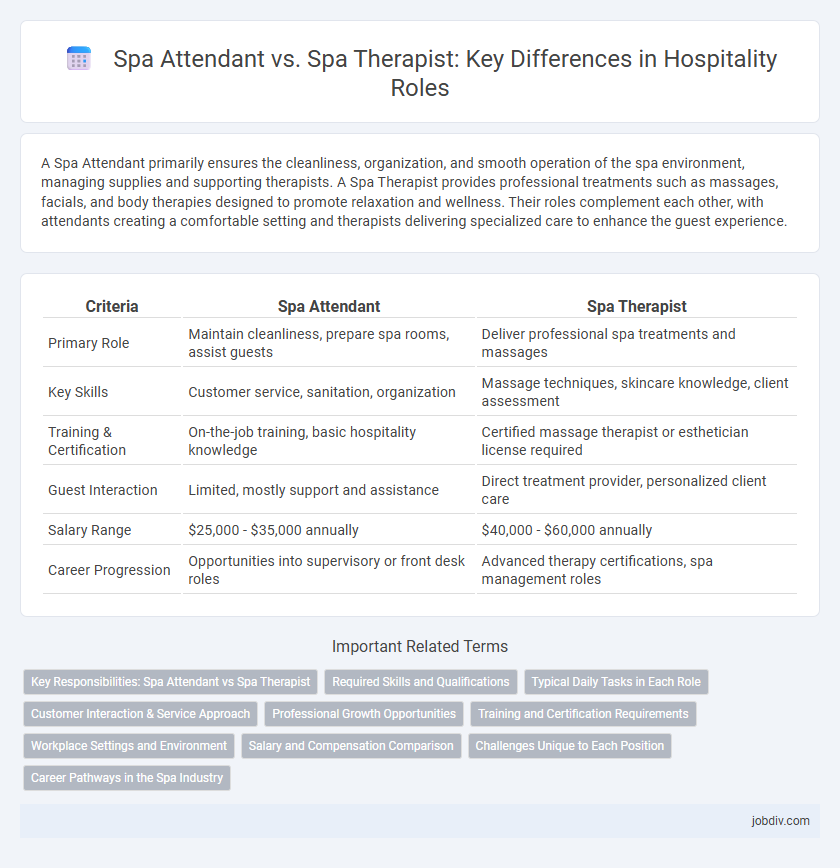A Spa Attendant primarily ensures the cleanliness, organization, and smooth operation of the spa environment, managing supplies and supporting therapists. A Spa Therapist provides professional treatments such as massages, facials, and body therapies designed to promote relaxation and wellness. Their roles complement each other, with attendants creating a comfortable setting and therapists delivering specialized care to enhance the guest experience.
Table of Comparison
| Criteria | Spa Attendant | Spa Therapist |
|---|---|---|
| Primary Role | Maintain cleanliness, prepare spa rooms, assist guests | Deliver professional spa treatments and massages |
| Key Skills | Customer service, sanitation, organization | Massage techniques, skincare knowledge, client assessment |
| Training & Certification | On-the-job training, basic hospitality knowledge | Certified massage therapist or esthetician license required |
| Guest Interaction | Limited, mostly support and assistance | Direct treatment provider, personalized client care |
| Salary Range | $25,000 - $35,000 annually | $40,000 - $60,000 annually |
| Career Progression | Opportunities into supervisory or front desk roles | Advanced therapy certifications, spa management roles |
Key Responsibilities: Spa Attendant vs Spa Therapist
Spa attendants primarily ensure the cleanliness and preparation of treatment rooms, manage inventory of spa supplies, and provide exceptional customer service by assisting guests with basic needs and facilitating a relaxing environment. Spa therapists specialize in delivering professional treatments such as massages, facials, and body therapies, applying expert knowledge of anatomy and treatment techniques to enhance client well-being. While attendants focus on operational support and ambiance, therapists are responsible for the direct application of therapeutic services to clients.
Required Skills and Qualifications
Spa Attendants require strong customer service skills, basic knowledge of spa treatments, and the ability to maintain cleanliness and organization in the spa environment. Spa Therapists must possess formal certifications in massage therapy or beauty treatments, deep knowledge of human anatomy, and advanced proficiency in delivering therapeutic and relaxation techniques. Both roles demand excellent communication skills and a commitment to enhancing guest wellness experiences.
Typical Daily Tasks in Each Role
Spa attendants maintain cleanliness, organize supplies, and prepare treatment rooms to ensure a welcoming environment. Spa therapists perform specialized treatments such as massages, facials, and body therapies tailored to individual client needs. Both roles require strong customer service skills, but therapists undergo specific training to deliver therapeutic services.
Customer Interaction & Service Approach
Spa attendants deliver essential support by maintaining cleanliness, preparing treatment rooms, and assisting clients with basic needs, ensuring a comfortable and welcoming environment throughout their visit. Spa therapists provide expert treatments such as massages, facials, and body therapies tailored to individual client preferences, engaging in personalized consultations to enhance relaxation and well-being. The customer interaction for spa therapists is more consultative and hands-on, focusing on therapeutic techniques, while spa attendants emphasize efficient service and seamless client experience behind the scenes.
Professional Growth Opportunities
Spa Therapists have extensive training in advanced treatments like massages and skincare, creating greater opportunities for specialization and career advancement within luxury resorts and wellness centers. Spa Attendants typically focus on maintaining cleanliness and customer comfort, with fewer pathways for professional development beyond supervisory roles. Investing in certification courses and hands-on therapy experience significantly enhances a Spa Therapist's potential to ascend to managerial or specialized wellness expert positions.
Training and Certification Requirements
Spa attendants typically require basic customer service training and on-the-job instruction, with certification in first aid often preferred but not mandatory. Spa therapists must complete specialized training programs in massage techniques, anatomy, and physiology, often culminating in nationally or internationally recognized certifications such as those from CIDESCO or ITEC. Regulatory requirements for spa therapists usually include formal education and licensure to ensure adherence to health and safety standards, whereas spa attendants focus more on operational support without extensive certification.
Workplace Settings and Environment
Spa Attendants typically work in hospitality settings such as hotels, resorts, and wellness centers, managing client preparation, cleanliness, and basic customer service in a fast-paced, guest-focused environment. Spa Therapists operate in more specialized environments like dedicated spas and medical wellness centers, providing therapeutic treatments, massages, and personalized wellness services requiring technical expertise and a calm, private setting. Both roles demand professionalism and interaction with clients, but Spa Therapists engage in hands-on therapy with a focus on health benefits, while Spa Attendants prioritize support and maintenance of the spa environment.
Salary and Compensation Comparison
Spa attendants typically earn an average hourly wage ranging from $12 to $18, focusing on maintenance, cleanliness, and customer service support, while spa therapists receive higher compensation between $20 and $40 per hour due to their specialized skills in massage and treatment techniques. Salary variations depend on location, spa type, and experience, with therapists often benefiting from tips and performance bonuses that boost overall earnings. Comprehensive compensation packages for therapists may also include health benefits and commission-based incentives, reflecting their advanced qualifications and client impact.
Challenges Unique to Each Position
Spa attendants face challenges such as maintaining cleanliness and organization while managing high guest turnover and ensuring prompt service under pressure. Spa therapists encounter the pressure of delivering personalized treatments tailored to diverse client needs, requiring extensive knowledge of various therapeutic techniques and strong interpersonal skills. Both roles demand adaptability and teamwork, but spa therapists often deal with emotional and physical client care complexities beyond the operational duties of spa attendants.
Career Pathways in the Spa Industry
Spa attendants typically start their careers performing essential support tasks such as maintaining cleanliness, preparing treatment rooms, and assisting therapists, providing a foundation for entry-level roles in the spa industry. Spa therapists require formal training in massage techniques, anatomy, and client care, enabling them to deliver specialized treatments and advance into senior therapist, spa supervisor, or wellness manager positions. Career progression in the spa industry often involves moving from support roles as spa attendants toward certified therapist qualifications, leading to greater responsibilities and higher earning potential.
Spa Attendant vs Spa Therapist Infographic

 jobdiv.com
jobdiv.com